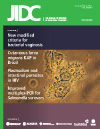The prevalence of congenital and perinatal cytomegalovirus infections among newborns of seropositive mothers
DOI:
https://doi.org/10.3855/jidc.2125Keywords:
Human cytomegalovirus, neonatal, congenital infection, perinatal infectionAbstract
Introduction: This study aimed to determine the prevalence of congenital and perinatal human cytomegalovirus (HCMV) infections among newborns in two major neonatal intensive care units (NICU) in Bahrain.
Methodology: One hundred newborns comprised of 84 preterm and 16 term babies admitted to the NICUs were enrolled in the study. During the first six weeks of life, urine and saliva was obtained from the babies weekly and serial breast milk samples were obtained from the mothers. Maternal serum HCMV IgG was measured. Virus isolation and detection was done by shell vial culture and nested PCR.
Results: Maternal HCMV IgG-seropositivity was 100%. Eight HCMV infections were detected comprising of three congenital and five perinatal infections. Congenital HCMV infection was found in preterm (2/84; 1.9%) and term (1/16; 6.3%) babies. HCMV DNA was detected in breast milk samples obtained during the first 10 days postpartum from all mothers whose babies had congenital HCMV. Forty-nine women provided breast milk samples between four and six weeks post-partum and HCMV DNA was detected in the breast milk of 11 women. Five (45.5%) of these eleven were mothers of babies with perinatal HCMV infection. There was no significant difference in the detection of HCMV using shell vial culture versus nested PCR method.
Conclusion: The findings indicate occurrence of congenital and perinatal HCMV transmission in this setting of high maternal seropositivity. The use of shell vial culture and PCR amplification for HCMV screening in the NICU for rapid detection of infection during the early postnatal period is recommended.
Downloads
Published
How to Cite
Issue
Section
License
Authors who publish with this journal agree to the following terms:
- Authors retain copyright and grant the journal right of first publication with the work simultaneously licensed under a Creative Commons Attribution License that allows others to share the work with an acknowledgement of the work's authorship and initial publication in this journal.
- Authors are able to enter into separate, additional contractual arrangements for the non-exclusive distribution of the journal's published version of the work (e.g., post it to an institutional repository or publish it in a book), with an acknowledgement of its initial publication in this journal.
- Authors are permitted and encouraged to post their work online (e.g., in institutional repositories or on their website) prior to and during the submission process, as it can lead to productive exchanges, as well as earlier and greater citation of published work (See The Effect of Open Access).








